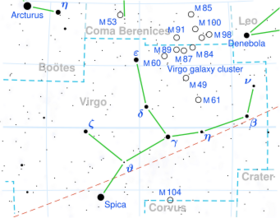Astronomy:Chi Virginis
| Observation data Equinox J2000.0]] (ICRS) | |
|---|---|
| Constellation | Virgo |
| Right ascension | 12h 39m 14.76696s[1] |
| Declination | −07° 59′ 44.0338″[1] |
| Apparent magnitude (V) | 4.652[2] |
| Characteristics | |
| Spectral type | K2 III[3] |
| U−B color index | +1.389[2] |
| B−V color index | +1.239[2] |
| Astrometry | |
| Radial velocity (Rv) | −19.7[4] km/s |
| Proper motion (μ) | RA: −77.223[1] mas/yr Dec.: −24.409[1] mas/yr |
| Parallax (π) | 10.3526 ± 0.1151[1] mas |
| Distance | 315 ± 4 ly (97 ± 1 pc) |
| Absolute magnitude (MV) | −0.29±0.19[5] |
| Details | |
| Mass | 2.17±0.28[6] M☉ |
| Radius | 23[7] R☉ |
| Luminosity | 182[7] L☉ |
| Surface gravity (log g) | 2.5[7] cgs |
| Temperature | 4,395[7] K |
| Metallicity | 0.06[7] |
| Rotational velocity (v sin i) | 3.9[7] km/s |
| Age | 0.86±0.34[5] Gyr |
| Other designations | |
26 Virginis, BD−07°3452, GC 17227, GCRV 7604, HD 110014, HIP 61740, HR 4813, PPM 195694, SAO 138892.[8] | |
| Database references | |
| SIMBAD | data |
| Exoplanet Archive | data |
| Extrasolar Planets Encyclopaedia | data |
Chi Virginis (χ Vir, χ Virginis) is a double star in the constellation Virgo. Based upon parallax measurements, it is approximately 315 light-years (97 parsecs) from Earth. It has an apparent visual magnitude of 4.65, which is bright enough to be seen with the unaided eye under suitable viewing conditions.
This star has a stellar classification of K2 III,[3] with the luminosity class "III" indicating that this is a giant star that has consumed the hydrogen at its core and evolved away from the main sequence. It has a mass about double that of the Sun[6] and has expanded to 23 times the Sun's radius, giving it a luminosity of 182 times the luminosity of the Sun.[7] The effective temperature of the star's outer envelope is about 4,395 K,[7] which gives the star the orange hue typical of K-type stars.[9] The abundance of elements other than hydrogen and helium, what astronomers term the star's metallicity, is slightly higher than in the Sun.[7]
This star has three optical companions. At an angular separation of 173.1 arcseconds is a magnitude +9.1 star, which is of spectral type K0. A 10th magnitude star is located 221.2 arcseconds away, and the third is a magnitude +9.1 K2 star 321.2 arcseconds away. None of these have been confirmed as a physical companion.[10]
In July 2009, it was discovered that Chi Virginis has a massive planet with a high orbital eccentricity of 0.46. It is orbiting with a period of about 835 days and has a mass at least 11 times greater than Jupiter. There are indications of a second planet orbiting with a period of 130 days, but this has not been firmly established.[11] But on 19 August 2015, the existence of a second planet, HD 110014 c (es), (about three times bigger than Jupiter and having an orbit roughly that of Venus) was confirmed by Chilean astronomer Maritza Soto.[12]
| Companion (in order from star) |
Mass | Semimajor axis (AU) |
Orbital period (days) |
Eccentricity | Inclination | Radius |
|---|---|---|---|---|---|---|
| b | ≥11.09 ± 1 MJ | 2.14 ± 0.03 | 835.477 ± 6 | 0.462 ± 0.069 | — | — |
See also
References
- ↑ 1.0 1.1 1.2 1.3 1.4 Vallenari, A. et al. (2022). "Gaia Data Release 3. Summary of the content and survey properties". Astronomy & Astrophysics. doi:10.1051/0004-6361/202243940 Gaia DR3 record for this source at VizieR.
- ↑ 2.0 2.1 2.2 Gutierrez-Moreno, A. et al. (1966), A System of photometric standards, 1, Publicaciones Universidad de Chile, Department de Astronomy, pp. 1–17, Bibcode: 1966PDAUC...1....1G
- ↑ 3.0 3.1 Buscombe, W. (1962), "Spectral classification of Southern fundamental stars", Mount Stromlo Observatory Mimeogram 4, Bibcode: 1962MtSOM...4....1B
- ↑ Wilson, R. E. (1953), General Catalogue of Stellar Radial Velocities, Carnegie Institute of Washington D.C., Bibcode: 1953GCRV..C......0W
- ↑ 5.0 5.1 da Silva, L. et al. (2006), "Basic physical parameters of a selected sample of evolved stars", Astronomy and Astrophysics 458 (2): 609–623, doi:10.1051/0004-6361:20065105, Bibcode: 2006A&A...458..609D
- ↑ 6.0 6.1 Kunitomo, M. et al. (2011), "Planet Engulfment by ~1.5–3 M⊙ Red Giants", The Astrophysical Journal 737 (2): 66, doi:10.1088/0004-637X/737/2/66, Bibcode: 2011ApJ...737...66K
- ↑ 7.0 7.1 7.2 7.3 7.4 7.5 7.6 7.7 7.8 Massarotti, A.; Latham, D. W.; Stefanik, R. P.; Fogel, J. (2008), "Rotational and Radial Velocities for a Sample of 761 HIPPARCOS Giants and the Role of Binarity", The Astronomical Journal 135 (1): 209–231, doi:10.1088/0004-6256/135/1/209, Bibcode: 2008AJ....135..209M
- ↑ "chi Vir -- Star in double system", SIMBAD (Centre de Données astronomiques de Strasbourg), http://simbad.u-strasbg.fr/simbad/sim-id?Ident=Chi+Virginis, retrieved 2011-12-30
- ↑ "The Colour of Stars", Australia Telescope, Outreach and Education (Commonwealth Scientific and Industrial Research Organisation), December 21, 2004, http://outreach.atnf.csiro.au/education/senior/astrophysics/photometry_colour.html, retrieved 2012-01-16
- ↑ Eggleton, P. P.; Tokovinin, A. A. (2008), "A catalogue of multiplicity among bright stellar systems", Monthly Notices of the Royal Astronomical Society 389 (2): 869–879, doi:10.1111/j.1365-2966.2008.13596.x, Bibcode: 2008MNRAS.389..869E
- ↑ de Medeiros, J. R. et al. (2009), "A planet around the evolved intermediate-mass star HD 110014", Astronomy and Astrophysics 504 (2): 617–623, doi:10.1051/0004-6361/200911658, Bibcode: 2009A&A...504..617D
- ↑ "Astronomer Discovers Planet 3 Times as Large as Jupiter". 20 August 2015. http://m.gadgets.ndtv.com/science/news/astronomer-discovers-planet-3-times-as-large-as-jupiter-730075.
 |


